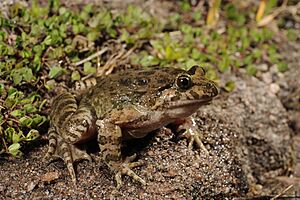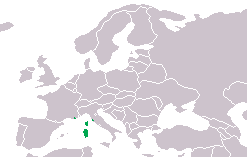Tyrrhenian painted frog facts for kids
Quick facts for kids Tyrrhenian painted frog |
|
|---|---|
 |
|
| Conservation status | |
| Scientific classification | |
 |
The Tyrrhenian painted frog (Discoglossus sardus) is a type of frog that belongs to the Alytidae family.
This special frog lives only in the Tyrrhenian Sea area. You can find it on a few islands in the Western Mediterranean. These islands include Sardinia, Corsica, and the Tuscan Archipelago. It looks very much like its cousin, the Corsican painted frog (Discoglossus montalentii). They even share some of the same living spaces in Corsica.
This frog lives in places like temperate forests, rivers, and freshwater marshes. It can be found from sea level all the way up to over 1,700 meters high. Even though it can handle a little water pollution, its home is still at risk from habitat loss.
The Tyrrhenian painted frog is not in immediate danger. It is listed as "Least Concern" (LC) on the IUCN Red List. However, it is still delicate and faces threats. This means strong efforts are needed to protect it in both France and Italy. In these countries, it is fully protected by law. Besides losing its home due to cities growing, the frog can also get a skin disease called chytridiomycosis. This disease threatens many amphibian species around the world.
Even though many people don't know about it, the Tyrrhenian painted frog is an important animal in several protected areas. One example is the Port-Cros National Park in France.
Contents
What Does the Tyrrhenian Painted Frog Look Like?
The Tyrrhenian painted frog is a small, strong amphibian. It usually grows to be about 5 to 7.5 centimeters (2 to 3 inches) long.
Its color can be dark brown, grey, black, or reddish-brown. It often has lighter spots, and frogs with no spots are rare. Most of the time, you will see a big light spot between its shoulders. There is also a large dark spot between its eyes, which has a straight, lighter front edge. Sometimes, a bright crescent-shaped spot can be seen on top of its head. This spot is usually between its nose and the middle of its eyes.
The frog's belly is yellowish to creamy white. Its pupil is shaped like a reversed teardrop. The iris (the colored part of the eye) is split. The top half is a lighter golden color, and the bottom half is darker. This eye feature is typical for frogs in the Discoglossus group. Like other frogs in this group, its eardrum is very hard to see.
Its skin is usually smooth. But during mating season, the males' skin becomes dry and rough. They also have soft bumps, called warts, on their neck and legs. These warts often form lines. The frog's head is wider than it is long. Its snout (nose area) is a bit pointy and thin. This is more noticeable than in its cousin, D. montalentii. The fourth finger on its front foot is flat, not pointy. Its back legs are also shorter.
Where Does the Tyrrhenian Painted Frog Live?
The Tyrrhenian painted frog lives in most parts of Corsica and Sardinia. However, it is not found in the central highlands of these islands. It also lives on several smaller islands in the Tyrrhenian Sea. These include Iles d'Hyères, Giglio, Montecristo, and the Monte Argentario peninsula in Tuscany.
Its homes include coastal plains, forest streams, maquis shrubland (a type of dense bushland), and upland forests with pine trees. It uses slow streams and pools for breeding. This frog can even live in slightly salty water, known as brackish water.
What it Eats and How it Reproduces
Like other frogs in its family, the Tyrrhenian painted frog eats small invertebrates. These are tiny creatures without backbones, like insects.
For a long time, it was hard to tell the Tyrrhenian painted frog apart from the Corsican painted frog. They look so similar! Scientists only realized they were different species in the late 20th century. Because of this, we don't know everything about how the Tyrrhenian painted frog reproduces. However, scientists believe it lays its eggs in small groups or one by one. The eggs are placed on the bottom of water bodies. They are brownish-black and about 1 to 1.5 millimeters (0.04 to 0.06 inches) wide. Each egg is covered in a thick, jelly-like layer.
How is the Tyrrhenian Painted Frog Protected?
The IUCN (International Union for Conservation of Nature) has listed this frog as "Least Concern." This means it is not currently in great danger of disappearing. The frog populations in Corsica and Sardinia seem to be stable. However, the groups of frogs on the mainland are getting smaller. Also, populations on very small islands might suffer from not having enough different genes.
The biggest dangers to this frog are when its forest and water homes are damaged. But the Tyrrhenian painted frog is quite adaptable. It can handle some changes to its habitat, which helps it survive.


